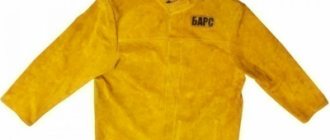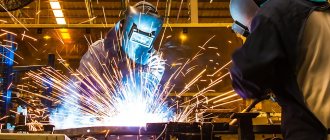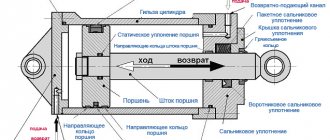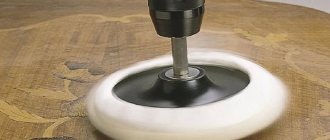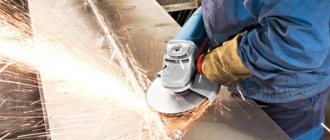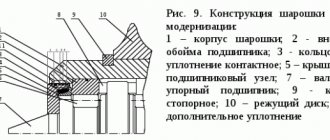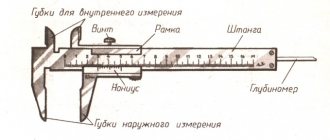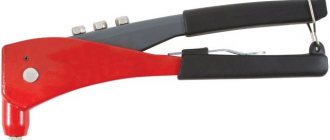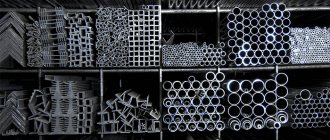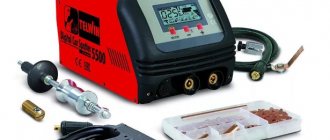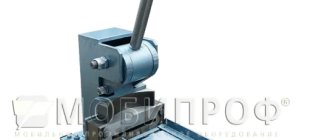Welder suit
—
special clothing designed to protect workers from sparks, splashes of molten metal, scale, and welding arc radiation.
Traditionally, suits are made of canvas fabric (i.e. tarpaulin consisting of cotton-linen fibers with fire-resistant impregnation), natural leather (split leather, less often yuft). Since the 2010s, welding suits made from pure cotton fibers with fire-resistant trim and fabrics based on para- and meta-aramid fibers have become widespread.
The main measurable indicator of the protective properties of welding clothing is resistance to burning through a drop of molten metal in seconds.
Fabrics made from meta- and para-aramid fibers have the greatest resistance to burning at the same density. Sometimes fabrics made from para-aramid fibers are additionally reinforced with a non-flammable silicone layer, which gives them additional thermal fire resistance.
Welding is a truly man's job, involving a high degree of danger. During welding work, a specialist risks his own health while fulfilling the customer’s requirements. The only thing that saves a worker is his uniform: suit , gloves , special shoes and a helmet . overalls deserve special attention - they protect a large area of the worker's body.
suit is made from fire-resistant fabric to protect against sparks, splashes of molten metal, and contact with heated surfaces. The material of the suit does not burn or melt when exposed to flame for a long time, which eliminates burns. Such clothing is used as the main means of protecting a person from high temperatures.
Welder overalls are very demanding on the quality of materials and tailoring. All models are certified and comply with GOST.
According to modern labor protection requirements, welders do not have the right to perform their work without special protection, which includes:
- Special suit that meets GOST requirements
- Safety shoes that are resistant to flying sparks and splashes of hot metal
- Fire-resistant work gloves, gauntlets or gloves (usually canvas)
- mask ( shield ) (for an electric welder) or special double glasses with a light filter (for a gas welder).
suits can be different, but their purpose is common - they protect the worker from interaction with sparks from the welding machine or radiation from the welding arc, and exposure to high temperatures. In contact with skin, such effects can cause severe burns and injury. Therefore, the materials from which this type of workwear is made are highly resistant to burning and exposure to high temperatures.
Today in stores you can buy suits made from a variety of materials that are resistant to burning. In particular, they must withstand exposure to a hot tungsten spiral (heating temperature is 800 degrees) for a certain time. This is how welding clothing is tested to ensure it meets stated fire resistance requirements.
Welding is a job that involves a high risk of contact with high temperatures, so safety precautions require a welding specialist to have not only an eye shield and very thick gloves, but also a special suit. Only such a set of special equipment can protect the welder from severe burns, metal scale and other health problems that can be caused by toxic welding fumes and infrared radiation that accompanies the welding process.
Types of welder suits
Options for the design of suits for welders regarding the use of fabrics may be different. work clothes are made from: tarpaulin, split leather and fabrics with impregnations that impart fire-retardant properties to the fabrics. There are also combined suits with several types of fabrics at once; this method can significantly reduce the cost of producing suits with virtually no deterioration in their properties, including allowing the creation of reinforced suits .
The most popular types of costumes:
Today, there are many types of welding clothing, but the most commonly used suits for welders are:
- suits ;
- suits ;
- suits with split leather (all-split, with inserts);
- suits made of suede, moleskin;
- suits (fire-resistant).
There is also a classification of suits according to climatic conditions:
- winter;
- summer
suit is the most widely used .
- Leather suit
The main advantage of such a suit is its density, which perfectly protects the welder from electrode sparks and molten metal splashes. The disadvantage of leather workwear is considered to be airtightness. In them, a person working in high temperatures will simply feel hot. When trying to solve this problem by perforating the suit, its protective properties deteriorate. It is possible to improve protection with the help of reinforced pads in the knees and elbows, which is quite often used when sewing leather suits. It is also worth noting that these clothes with special fire-resistant threads.
- All-piece suit
Split grain is one of the layers of natural leather into which it is divided during sanding (a thinning process used in the production of leather shoes). The split layer is the second after the front layer. This material very well protects the welder from metal sparks and molten metal generated during the electrode combustion process. Since split leather is a leather derivative, its pros and cons are the same as those of genuine leather, but the cost is less.
The suit can be completely covered with split leather, in which case it will be called all-split leather, or it can have only fragmentary split leather inserts, depending on the most endangered areas of the human body. Thus, suit has an area covered with split leather of at least 2.3 square meters. m of clothing (partially arms, chest and stomach). In a 2.6 split also protects 30 cm of the neckline.
- Canvas suit
Such clothing is only suitable for short welding work, since prolonged contact with the temperature may cause it to ignite. Another disadvantage is the fact that the welder will have to shake off the metal scale himself. But the canvas suit also has its advantages. This is excellent ventilation, which is especially valuable for work in the summer.
If we compare the three above-mentioned types of suit, the first, leather, is the most fire-resistant. When tested with a tungsten filament heated to 1000 degrees, a leather suit Second place goes to the split leather counterpart, but the canvas suit . By the way, the standard for resistance to burning is a period of 6-8 seconds.
- Cloth suits
They are excellent for protection in metallurgy and other industries in contact with very hot surfaces. Both cloth and tarpaulin must be treated with a special impregnation, then they will be truly fireproof. Very often these materials are combined in one product. And yet, their level of protection remains basic, and only leather and split-split analogues of workwear have enhanced properties, so you can often find a cloth or canvas suit , reinforced with split-split inserts. Canvas and cloth suits have an advantage over leather and split leather in cost. They are significantly cheaper. Inserts are also sewn onto cloth workwear, most often not from leather, but from split leather. It is practically not inferior in protective properties to skin, but its cost is more favorable.
- Seasonal costumes
Keeping in mind the different climatic conditions of welders’ work, there is another division of suits into summer and winter varieties. Summer suits include cloth, canvas, and suits . Winter ones are most often all-split leather, one-piece leather and various insulated clothing options (based on tarpaulin, cloth, moleskin). Moreover, the insulation ( calico , batting ) can be either embroidered or detachable.
A summer welding suit is created from the thinnest cuts of the selected material so that the employee feels very comfortable in it and is always confident in his safety. These suits are perfect for welding work in workshop conditions.
Winter welding clothing contains a lining inside made of compacted fireproof material, in the form of which waterproof tarpaulin fabrics can be used. suits usually consist of overalls, while separate ones contain a jacket and additional pants. The most popular and sought-after suits usually include the following model:
- All-piece welding suit .
This model is lined with split leather, this substance is produced by processing leather. This very material best protects employees from hot metals and electrode sparks formed during welding.
Equipment options, description
The welding form includes a mask (face shield) or special glasses that perform a protective function and are supplemented with light filters.
A welder's summer clothing consists of pants and a jacket made of thick material. The worker wears reliable shoes made of genuine leather on his feet. Hands are protected with bulky gloves or mittens.
The winter version includes overalls and a jacket. The straps are adjustable to suit the welder's height , and there is an elastic band around the waist. A variant of winter workwear for a welder is shown in the photo:
Gloves (or leggings) are made of pork or beef leather. On top of it they are coated with a heat-resistant substance. Winter leggings are insulated with an additional layer of fur . The gloves are necessarily equipped with a socket, which ensures quick release of the welder’s hands. The inner layer is made of natural cotton fiber.
Five-fingered, two- and three-fingered gloves are available.
The former are suitable for carrying out tasks that require increased precision of execution. The second - for other types of work. Boots must have metal toe caps and reinforced polyurethane soles . In hazardous conditions, shoes with nitrile soles are preferred.
Standards and requirements for creating suits for welders
All suits intended for welding, like special clothing, have a number of standards by which the quality of the product is assessed: First of all, it is necessary that suit has a suitable outline of trousers, jackets and overalls; Welders very often work in dangerous and difficult-to-reach areas, so workwear is sometimes equipped with additional softening padding on the elbows and knees 1) In addition, workwear for welders must be treated with waterproof impregnation. 2) The employee should feel comfortable and comfortable in it. 3) Also, special welding clothing should not hinder the action, but at the same time, the ends of the sleeves and jacket should not be loose. If these standards are violated or if the welder feels discomfort, all this can contribute to a disruption or decrease in the speed of the welding process.
Why do you need special clothing?
It is no coincidence that the welding profession is considered one of the most dangerous.
The fact is that during work, the skin can interact with open fire, sparks and splashes of liquid metal, which can lead to serious burns and injuries. In addition, this work often takes place in conditions of loud noise, and there remains a high risk of being exposed to the negative effects of electric current. In most cases, workers have to carry out welding in not very comfortable conditions, in confined spaces or at fairly high altitudes, where there is a high probability of a person falling or the devices and devices they use in their work. To minimize the negative impact of these factors and preserve their health and life, every welder must have a special welding suit that will help make his work safer.
Requirements for welder clothing:
- All suits for welders must comply with the requirements of regulatory documents GOST 12.4.045-87, GOST 12.4.029-76, TU 1708-327-91, TU 8572-017-00302190-93
- Resistant to high temperatures;
- Resistance to deformation at elevated temperatures;
- Protection of the worker from overheating (presence of ventilation holes);
- Comfortable clothing;
- Burn-through resistance (increased protection against sparks and metal splashes) for a minimum of 50 seconds.
Fabrics used for making welder's clothing:
- Tarpaulin : the main material for making such clothing. Made from natural raw materials: cotton or linen. The density of Tarpaulin is usually from 300 to 600 g/m. suit made of tarpaulin is usually not very convenient to use, since the tarpaulin hinders movement. Caring for such suits can only be done by dry cleaning, since during industrial washing the tarpaulin shrinks and hardens.
- Genuine leather : Split leather , yuft . suit made from split leather is more convenient to use, but just like tarpaulin, it requires dry cleaning and is afraid of water (it becomes hard after drying).
- Special fabrics made from natural or synthetic fibers: Moleskine (durable cotton fabric). For the manufacture of welder's clothing, fabric of the S28-YUD brand is used. This fabric complies with GOST 11209-85 and can withstand direct exposure to fire for 20-30 seconds, during which it does not smolder or burn.
- WESTEX fabrics: INDURA (100% cotton ) and INDURA ULTRA SOFT (88% cotton , 12% high-strength nylon ). The burn resistance of these fabrics ranges from 117 to 165 seconds.
- WELDERSAFE fabric with a density of 440 g/m2 with a satin weave and burn resistance of 149 seconds, at a standard not a suit ) compared to canvas. The use of WELDERSAFE fabric reduces to zero the likelihood of third-degree burns from thermal exposure; it is precisely this type of burn that leads to death. Also, this fabric contains virtually no free formaldehyde, a strong carcinogen that causes cancer.
The most widely used suit is made of canvas. This material is distinguished not only by its increased strength, but also by its relatively low cost. In accordance with the basic requirements for fabrics used for the production of suits, these materials must be resistant to burning for at least 50 seconds. welding suit The set includes a jacket and trousers . The jacket has a special hidden fastener and pockets in the side seams. The collar is trimmed with calico.
They have high protective properties and are comfortable to wear. Even with repeated cleanings, they retain their fire-resistant properties. There are also special ventilation holes to prevent the worker from overheating. This suit does not restrict movement and allows you to work comfortably throughout the working day.
Suits with fire-resistant impregnations
A welder's suit made from fabrics with fire-resistant impregnations is, as a rule, more comfortable and is not afraid of industrial washing and dry cleaning. After washing, it retains the fabric structure and fire-retardant properties, which allows you to use such a suit with increased comfort. Fire retardant properties in such fabrics are achieved by using impregnations using PROBAN and PYROVATEX technologies. Such methods of fabric impregnation make it possible to maintain fire-retardant properties for the entire service life of welders' suits . Fabrics with fire-resistant impregnations are usually made of 100% cotton, the density of such fabrics ranges from 300 g/m2 to 450-500 g/m2. The only drawback of suits made from such fabrics is their expensive price.
How is a fabric's burn resistance determined?
The tightly stretched fabric is exposed to a tungsten helix heated to 800 C and the time during which the fabric remains intact is measured. The higher this indicator, the better the fabric and the more resistant it is to burning.
Additional items of workwear
Since welders often have to work in a sitting and standing position, a leather apron that can cover almost the entire body would be useful for the welding suit they use. If metal or slag particles accidentally get on the apron, they will not cause damage to the workwear. A set of winter clothing for a welder should contain warm mittens or gloves with gauntlets. The robe must have special ventilation holes. The fact is that it is made of high-density material and can be hot in it.
